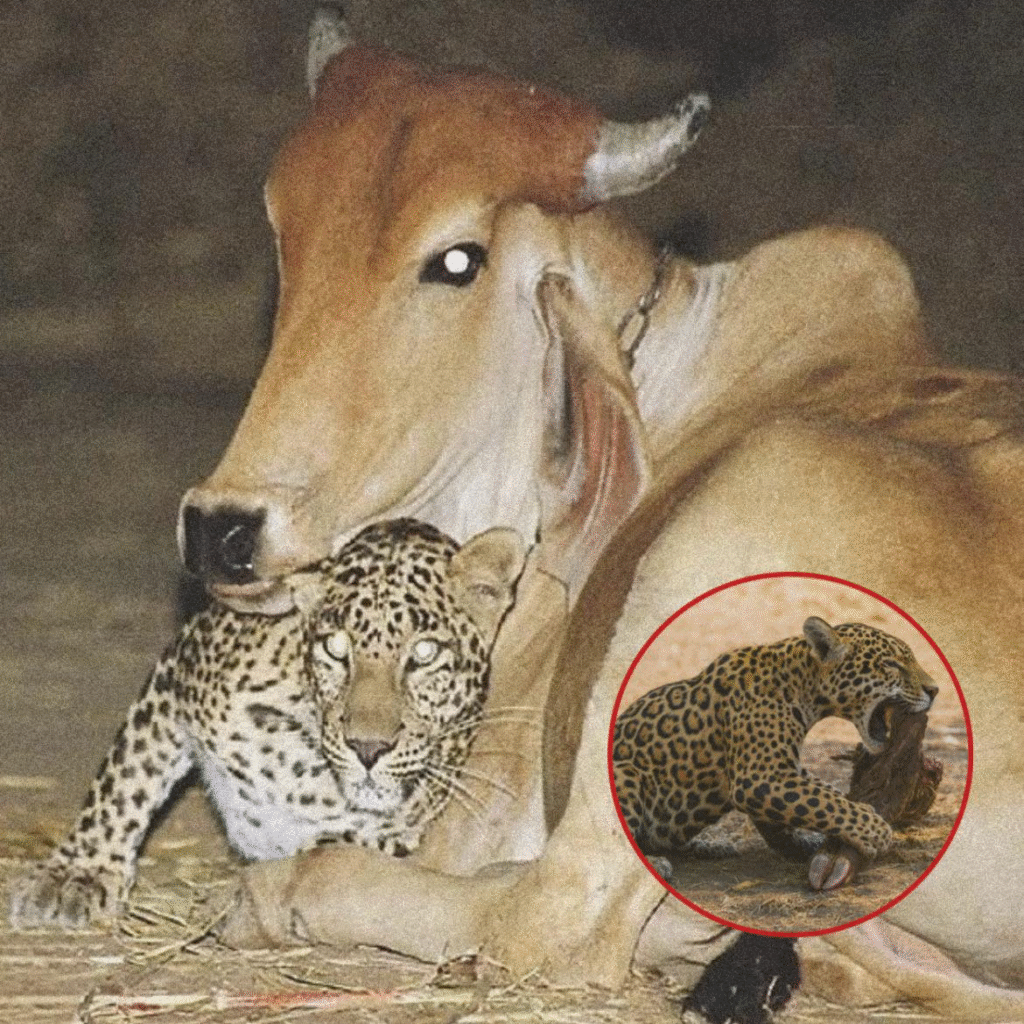
For years, the villagers whispered about the strange sight at the edge of town. In the dark of winter, when frost crept over the valley and snow silenced the fields, a jaguar and a cow could be seen lying side by side. Sometimes they rested beneath the dim glow of a streetlamp, other times pressed against the wall of a shed, their bodies huddled close to trap what warmth they could. No one dared disturb them, for it was a fragile balance, a story of survival that seemed too delicate to question.
What astonished the villagers most was not simply the pairing, but the peace. A predator and prey, natural enemies in every sense, had chosen coexistence. They did not fight. They did not flee. Through the long winters, they endured together. The cow, heavy-bodied and calm, offered heat and companionship. The jaguar, feared hunter of the forest, seemed to understand that survival in those conditions demanded something other than instinct.
For four winters, they remained like this. Each season brought harsh winds and biting nights, but together they resisted. It became almost ordinary to see them curled against each other, steam rising from their mingled breath in the frozen air. To the villagers, it was a parable written in fur and snow: patience, trust, and endurance bound even the most unlikely of allies.
But balance in nature is fragile, and in one season of human greed, everything began to unravel. That summer, loggers cut their way through the valley, leaving stumps where trees had once stood. The forest was stripped bare, and with it went the deer and guanacos that had fed generations of jaguars. The great cats found themselves prowling empty ground, driven closer and closer to starvation.

The jaguar that had once leaned against a cow for warmth now walked the valley gaunt and restless. His ribs began to show through his hide. His steps lost their strength. Hunger gnawed at him like fire from within, and in that hunger, the fragile pact between predator and companion began to crack.
He hunted what he could—mice, rabbits, scraps of game too small to satisfy a creature of his size. But each meal only sharpened his appetite. Nights became longer, days emptier, until at last the temptation became unbearable.
One evening, as the summer light stretched thin across the valley, the jaguar made the choice that would undo him. He turned to the one creature who had been at his side through years of snow and hardship. Driven by hunger stronger than memory, he struck. The villagers found only traces the next day: the remains of the cow that had once kept him alive through the bitter cold.
The act seemed almost unthinkable. For years, they had endured together. And yet, in one night, the fragile bond was destroyed. Where trust had once sheltered them, appetite now took everything. The jaguar had gained a full stomach, but he had lost his only ally.
When winter returned, the valley grew cruel once more. The winds howled across barren fields stripped by deforestation, snow pressed heavy against the earth, and temperatures dropped below survival’s threshold. The jaguar, now alone, had no warmth to share, no body to lean against. He roamed in circles, thinner with each passing day, his strength dissipating with every step.
The villagers saw less and less of him as the season deepened. At first, only fleeting glimpses—an outline against the tree line, eyes reflecting faint firelight in the night. Then, nothing. Silence replaced the tale that had once enchanted the town. When at last he was found, it was too late. His body lay stiff in the snow, frozen where he had fallen.
In his hunger, he had chosen immediacy over endurance. He had traded years of survival for a single night of satisfaction. The irony was bitter and unyielding: had he clung to patience, had he endured on scraps of mice and rabbits, he might have seen another spring. Instead, the hunger that saved him in small measures betrayed him in one decisive act.
The villagers mourned the loss in silence, for the story had never truly belonged to them. It was not just the death of a jaguar, nor the end of a cow. It was the collapse of something rare and fragile—a partnership that had defied nature’s rules until man’s destruction and hunger’s temptation tore it apart.
Around firelight and winter tables, they told the story again and again. Some spoke of it as a fable of greed, a lesson in the danger of taking what cannot be replaced. Others saw it as a lament for the vanishing forests, a reminder of how quickly balance can be shattered when human hands strip away the foundation of life.
In the end, the tale was remembered as both tragedy and warning. It spoke of how survival depends not only on strength, but on patience, restraint, and the bonds we form in times of scarcity. The jaguar had once known this truth, lying pressed against a cow through nights so cold the air itself seemed to crack. But one moment of weakness erased years of endurance.
The valley healed slowly, but the memory remained. Children grew up hearing of the jaguar and the cow, of winters where predator and prey lay side by side. They learned that survival is not always written in teeth and claws. Sometimes it is found in unlikely companionships, and sometimes it is destroyed by the hunger that blinds us to the value of what we already have.
And so, in the silence of the valley winters, the story lingers: the tale of a jaguar who ate his only friend, and discovered too late that warmth and patience were the truest meals he would ever know.